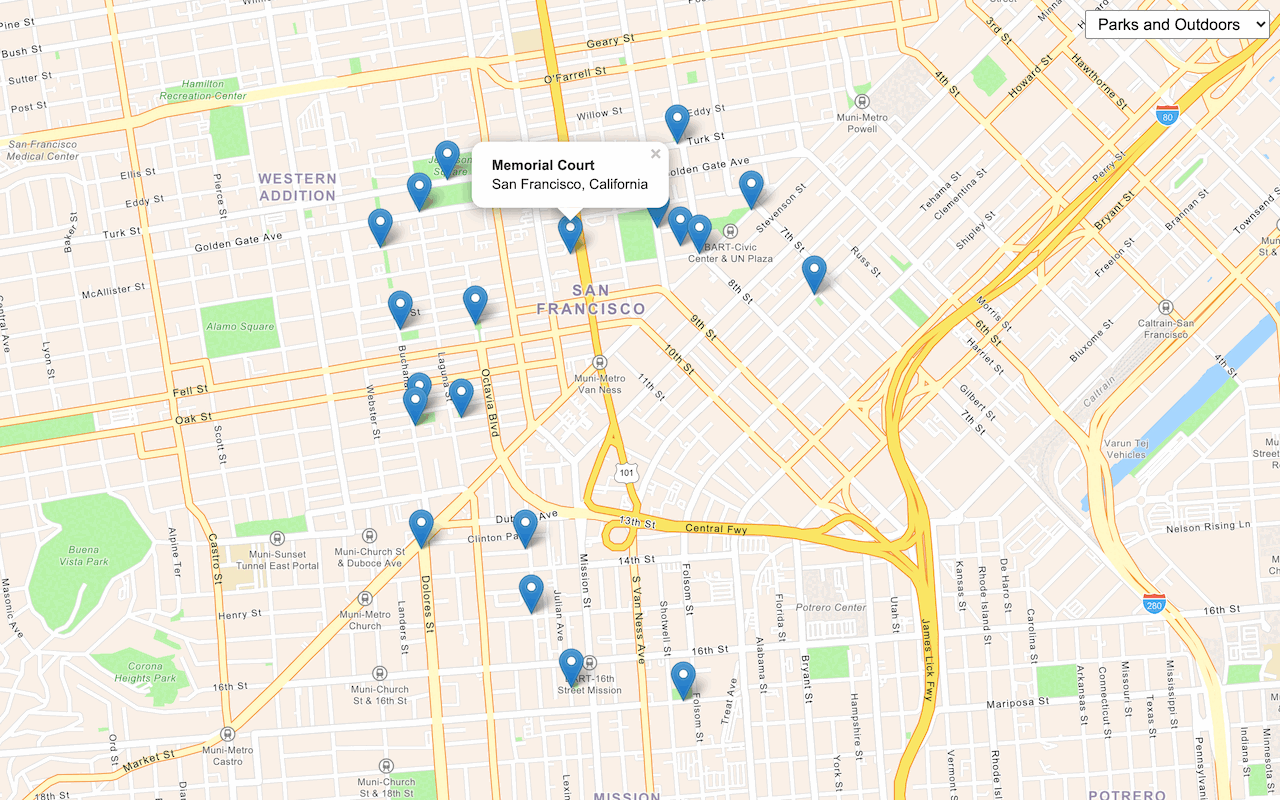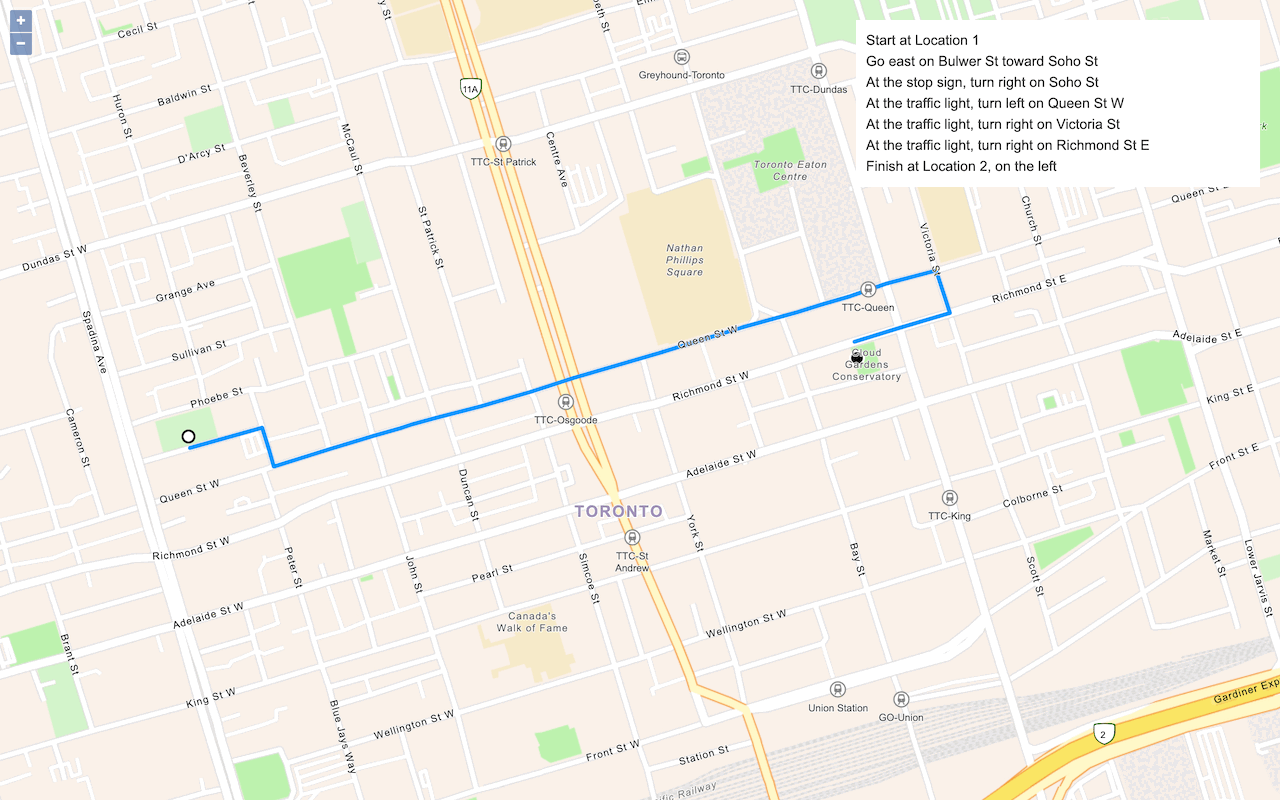Learn how to find an address near a location.
The ArcGIS Geocoding service allows you to perform reverse geocode. Reverse geocoding is the process of converting a location to an address or place. This operation requires an initial location and returns an address with attributes such as place name and location.
In this tutorial, use the MapLibre ArcGIS plugin to display a map and ArcGIS REST JS to reverse geocode and find the closest address to your clicked location on the map.
Prerequisites
You need an ArcGIS Location Platform or ArcGIS Online account.
Steps
Get the starter app
Select a type of authentication and follow the steps to create a new app.
Choose API key authentication if you:
- Want the easiest way to get started.
- Want to build public applications that access ArcGIS Location Services and secure items.
- Have an ArcGIS Location Platform or ArcGIS Online account.
Choose user authentication if you:
- Want to build private applications.
- Require application users to sign in with their own ArcGIS account and access resources their behalf.
- Have an ArcGIS Online account.
To learn more about both types of authentication, go to Authentication.
Set up authentication
Set developer credentials
Use the API key or OAuth developer credentials so your application can access ArcGIS services.
Add references to ArcGIS REST JS
This tutorial uses ArcGIS REST JS for reverse geocoding.
-
In the
<headelement, add references to the ArcGIS REST JS library.> Use dark colors for code blocks <head> <title>MapLibre ArcGIS tutorial: Reverse geocode</title> <meta charset="utf-8"> <meta name="viewport" content="initial-scale=1,maximum-scale=1,user-scalable=no"> <!-- Load MapLibre GL JS from CDN --> <script src="https://unpkg.com/maplibre-gl@5.14.0/dist/maplibre-gl.js"></script> <link href="https://unpkg.com/maplibre-gl@5.14.0/dist/maplibre-gl.css" rel="stylesheet"> <!-- Load MapLibre ArcGIS from CDN --> <script src="https://unpkg.com/@esri/maplibre-arcgis@1.0.0/dist/umd/maplibre-arcgis.min.js"></script> <script src="https://unpkg.com/@esri/arcgis-rest-request@4/dist/bundled/request.umd.js"></script> <script src="https://unpkg.com/@esri/arcgis-rest-geocoding@4/dist/bundled/geocoding.umd.js"></script>
Update the map
An arcgis/navigation basemap style is typically used in geocoding and routing applications. Update the basemap layer to use the style.
-
Update the basemap and the map initialization to center on location
[2.3522,48.8566], Paris.Use dark colors for code blocks <script> /* Use for API key authentication */ const accessToken = "YOUR_ACCESS_TOKEN"; // or /* Use for user authentication */ // const session = await arcgisRest.ArcGISIdentityManager.beginOAuth2({ // clientId: "YOUR_CLIENT_ID", // Your client ID from OAuth credentials // redirectUri: "YOUR_REDIRECT_URI", // The redirect URL registered in your OAuth credentials // portal: "YOUR_PORTAL_URL" // Your portal URL // }) // const accessToken = session.token; const map = new maplibregl.Map({ container: "map", zoom: 12, center: [2.3522, 48.8566] // Paris }); const basemapStyle = maplibreArcGIS.BasemapStyle.applyStyle(map, { style: "arcgis/navigation", token: accessToken }); </script>
Add a click event handler
Before you call the Geocoding service, you need to get a location from the user. You can add a handler to the Map's click event. The click handler will be called with an object containing parameters such as lng.
The lng property is a Lng. It has lng and lat properties and a to method which returns an array in [longitude, latitude] order.
-
After the map initialization code, add a handler for the
clickevent. Create a coordinates array from thelngproperty of the event parameter.Lat Use dark colors for code blocks <script> /* Use for API key authentication */ const accessToken = "YOUR_ACCESS_TOKEN"; // or /* Use for user authentication */ // const session = await arcgisRest.ArcGISIdentityManager.beginOAuth2({ // clientId: "YOUR_CLIENT_ID", // Your client ID from OAuth credentials // redirectUri: "YOUR_REDIRECT_URI", // The redirect URL registered in your OAuth credentials // portal: "YOUR_PORTAL_URL" // Your portal URL // }) // const accessToken = session.token; const map = new maplibregl.Map({ container: "map", zoom: 12, center: [2.3522, 48.8566] // Paris }); const basemapStyle = maplibreArcGIS.BasemapStyle.applyStyle(map, { style: "arcgis/navigation", token: accessToken }); map.on("click", (e) => { const coords = e.lngLat.toArray(); }); </script>
Call the service
Use the ArcGIS REST JS reverse method to find an address closest to a point.
-
Inside the click handler, call the
arcgismethod and pass in the coordinates array.Rest.reverse Geocode Use dark colors for code blocks map.on("click", (e) => { const coords = e.lngLat.toArray(); const authentication = arcgisRest.ApiKeyManager.fromKey(accessToken); arcgisRest .reverseGeocode(coords, { authentication }) .then((result) => { });
Display the result
The response from the reverse operation contains two properties. address is a structured object with fields such as street name and business name. location contains the location of the returned address, which may differ from the coordinates you provided.
Use the results to display a pop-up with the address and location values.
-
Convert the
result.locationobject into an array of[longitude, latitude].Use dark colors for code blocks arcgisRest .reverseGeocode(coords, { authentication }) .then((result) => { const lngLat = [result.location.x, result.location.y]; -
Set a variable containing the text you want to display, using the address and coordinates.
Use dark colors for code blocks const lngLat = [result.location.x, result.location.y]; const label = `${result.address.LongLabel}<br>${lngLat[0].toLocaleString()}, ${lngLat[1].toLocaleString()}`; }) -
Add a pop-up to display the label at the returned coordinates.
To add a pop-up to the map, you use the
Popupclass in MapLibre GL JS. See the Display a pop-up tutorial for more information.Use dark colors for code blocks const lngLat = [result.location.x, result.location.y]; const label = `${result.address.LongLabel}<br>${lngLat[0].toLocaleString()}, ${lngLat[1].toLocaleString()}`; new maplibregl.Popup().setLngLat(lngLat).setHTML(label).addTo(map); })
Handle errors
To handle errors that occur when accessing the Geocoding service, such as networking or API key issues, use an error handler to show a message to the user.
-
Add a handler to catch any exception and display a message to the user.
Use dark colors for code blocks const authentication = arcgisRest.ApiKeyManager.fromKey(accessToken); arcgisRest .reverseGeocode(coords, { authentication }) .then((result) => { const lngLat = [result.location.x, result.location.y]; const label = `${result.address.LongLabel}<br>${lngLat[0].toLocaleString()}, ${lngLat[1].toLocaleString()}`; new maplibregl.Popup().setLngLat(lngLat).setHTML(label).addTo(map); }) .catch((error) => { alert("There was a problem using the reverse geocode service. See the console for details."); console.error(error); });
Run the app
Run the app.
Click on the map to reverse geocode the clicked point and display a pop-up with the closest address and coordinates.What's next?
Learn how to use additional location services in these tutorials:


